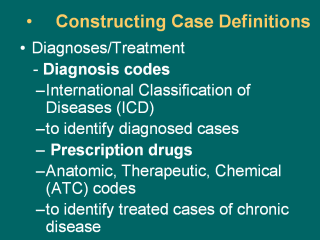| front |1 |2 |3 |4 |5 |6 |7 |8 |9 |10 |11 |12 |13 |14 |15 |16 |17 |18 |19 |20 |21 |22 |23 |24 |review |
 |
The purpose
of the MCHP research report “Defining and Validating Chronic
Diseases: An Administrative Data Approach”, was to investigate the
validity of administrative data for chronic disease surveillance.
In order to
use administrative data for chronic disease surveillance, a disease
case definition needs to be constructed. A case definition is
the set of rules to distinguish one disease from another.
Essentially, applying a case definition to a databases
filters the “hits” from the “misses”.
These “hits” are the identified disease cases.
Some
elements of a case definition include: the type of data source,
the number of years to include, diagnostic/treatment
code(s), and the number of ‘contacts’ an individual has
with a specific diagnostic/treatment code.
Studies have suggested that the ability of a case definition
to identify a disease from administrative data is sensitive to how
elements of these case definitions are manipulated (Robinson et al.,
1997; Powell, 2003; Rector et al., 2004).
One solution is to apply multiple case definitions to
administrative data to produce a probable range of estimates.
Three
sources of population-based administrative data were used to
construct the case definitions – 1) The physician database,
which captures billing information from all fee-for-service
physicians and the majority of salaried physicians in the province
of Manitoba, Canada; 2) The hospital database, which records
all separations from acute care facilities in Manitoba, Canada; and
3) The Drug Programs Information Network (DPIN), which is a
centralized database that captures
pharmaceutical dispensations from all retail pharmacy outlets
in Manitoba, Canada.
Diagnoses in the physician and hospital data are recorded using
ICD-9-CM. Prescription drugs can be linked to Anatomic, Therapeutic,
Chemical (ATC) codes.
|